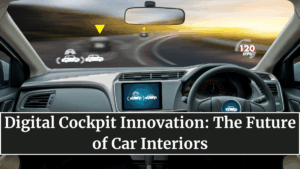Step inside a 2025 car, and you’ll realize — the steering wheel is no longer the star. The dashboard is now a digital experience zone, merging hardware, software, and human emotion into one intelligent environment. The rise of digital cockpit and in-car UX innovation marks a transformation of how drivers interact with vehicles, turning every ride into an immersive, connected experience.
The car interior has evolved from analog buttons and dials to panoramic touchscreens, AI voice assistants, and adaptive displays that learn your preferences. It’s no longer just about driving; it’s about being part of a seamless, sensory digital journey.

What Is a Digital Cockpit?
A digital cockpit integrates all driver and passenger interfaces — from infotainment and navigation to safety controls — into one connected ecosystem. It combines hardware like displays, cameras, and sensors with software powered by AI and cloud connectivity.
These systems are built to provide:
-
Unified control of entertainment, safety, and comfort.
-
Personalized experiences based on driver profiles.
-
Voice and gesture-based commands for distraction-free driving.
-
Real-time vehicle and environment feedback through augmented displays.
In simple terms, the digital cockpit turns the car into an extension of your smartphone — intuitive, intelligent, and constantly connected.
The Core Technologies Behind Modern Cockpits
Automakers are combining several advanced technologies to power these next-gen interiors:
-
AR Heads-Up Displays (HUDs): Project navigation, speed, and alerts directly onto the windshield.
-
AI Assistants: Natural-language systems that manage music, navigation, and cabin settings.
-
Haptic Feedback Panels: Touch surfaces that “click” back with physical sensations.
-
Ambient Lighting Systems: Adaptive lighting that matches driving mode and mood.
-
5G Connectivity: Enables seamless cloud-based infotainment, streaming, and updates.
Together, these elements create an environment that responds dynamically to the driver’s mood, behavior, and context.
Automakers Redefining the In-Car UX
Global car manufacturers are in a creative race to redefine the digital experience inside vehicles.
| Brand | Innovation | Highlight Feature |
|---|---|---|
| Mercedes-Benz | MBUX Hyperscreen | 56-inch continuous OLED panel with AI-powered interface |
| BMW | iDrive 9 | Mixed-reality cockpit with curved displays and voice integration |
| Tesla | Full Touch Control | Centralized digital hub replacing traditional switches |
| Hyundai | ccOS (Connected Car OS) | AI-based personalization and split-screen media |
| Volvo | Android Automotive OS | Integrated Google ecosystem for seamless connectivity |
Each design prioritizes minimalism, intuition, and personalization, blending aesthetics with intelligence.
How In-Car UX Is Becoming Human-Centered
Today’s automotive UX (user experience) design is shifting from machine-centric to emotion-driven. Cars are learning to sense the driver’s stress, adjust cabin temperature, dim lighting, and play soothing music automatically.
Artificial intelligence not only recognizes who is driving but also how they’re feeling. Facial recognition systems track fatigue, while seat sensors measure posture to recommend rest breaks. This new UX philosophy is turning vehicles into empathetic companions — not just machines.
Sustainability and Minimalism in Interior Design
Modern cockpits are also reflecting the shift toward sustainability and smart materials. Automakers are moving from leather and plastics to recycled composites, vegan leather, bamboo fiber panels, and plant-based fabrics.
The result is a cabin that looks futuristic but feels natural — combining sustainability with luxury. Ambient lighting and simplified dashboards also reduce clutter, giving interiors a Zen-like calm that enhances focus and safety.
The Future of the Digital Driving Experience
By 2030, the digital cockpit will be more than a dashboard — it will be a living digital ecosystem. Cars will feature adaptive UIs that change based on time, location, and driver habits. Imagine your vehicle shifting into “Work Mode” during commutes, displaying your schedule, or “Relax Mode” after a long day, dimming lights and playing your favorite playlist.
AI-driven systems will also predict needs — such as suggesting charging stops, restaurant breaks, or nearby hotels based on your journey history. The cockpit of the future won’t just display data; it will understand context and enhance emotional well-being.
The New Benchmark of Automotive Luxury
Luxury in 2025 isn’t just about horsepower or badges — it’s about how your car interacts with you. The next generation of drivers expects digital serenity: an environment that connects seamlessly with their digital life while keeping them safe and comfortable.
As the lines blur between car, computer, and companion, the digital cockpit becomes the beating heart of automotive innovation — where technology meets emotion and driving transforms into an intelligent experience.
FAQs
What is a digital cockpit in cars?
A digital cockpit integrates infotainment, safety, and connectivity features into one seamless, screen-based system powered by AI.
How does in-car UX innovation improve driving?
It enhances safety, comfort, and engagement by offering personalized controls, smart automation, and intuitive interfaces.
Which car brands lead in digital cockpit design?
Mercedes-Benz, BMW, Tesla, Hyundai, and Volvo are among the pioneers redefining in-car experiences with advanced UX systems.
What role does AI play in modern cockpits?
AI personalizes driving settings, manages voice controls, and analyzes driver emotions to deliver a smoother, more adaptive experience.
What’s the future of in-car UX?
Future cockpits will use AI, AR, and adaptive design to create emotionally intelligent, sustainable, and fully connected mobility spaces.
Click here to know more.
